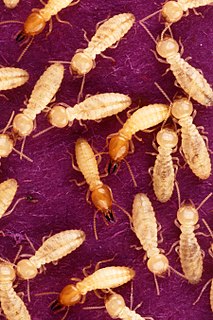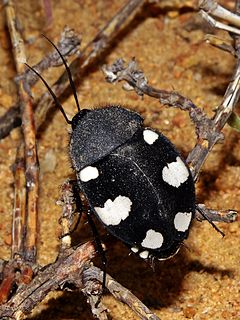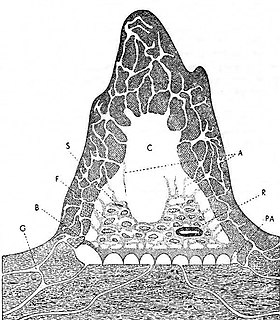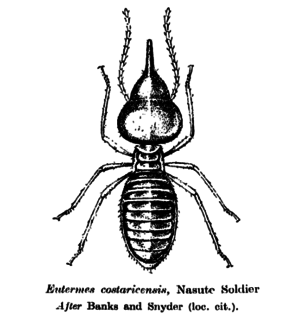
Termites are eusocial insects that are classified at the taxonomic rank of infraorder Isoptera, or alternatively as epifamily Termitoidae, within the order Blattodea. Termites were once classified in a separate order from cockroaches, but recent phylogenetic studies indicate that they evolved from cockroaches, as they are deeply nested within the group, and the sister group to wood eating cockroaches of the genus Cryptocercus. Previous estimates suggested the divergence took place during the Jurassic or Triassic. More recent estimates suggest they have an origin during the Late Jurassic, with the first fossil records in the Early Cretaceous. About 3,106 species are currently described, with a few hundred more left to be described. Although these insects are often called "white ants", they are not ants, and are not closely related to ants.

Dictyoptera is an insect superorder that includes two extant orders of polyneopterous insects: the order Blattodea and the order Mantodea (mantises). While all modern Dictyoptera have short ovipositors, the oldest fossils of Dictyoptera have long ovipositors, much like members of the Orthoptera.

Blattodea is an order of insects that contains cockroaches and termites. Formerly, the termites were considered a separate order, Isoptera, but genetic and molecular evidence suggests an intimate relationship with the cockroaches, both cockroaches and termites having evolved from a common ancestor. The Blattodea and the mantises are now all considered part of the superorder Dictyoptera. Blattodea includes approximately 4,400 species of cockroach in almost 500 genera, and about 3,000 species of termite in around 300 genera.

Eusociality, the highest level of organization of sociality, is defined by the following characteristics: cooperative brood care, overlapping generations within a colony of adults, and a division of labor into reproductive and non-reproductive groups. The division of labor creates specialized behavioral groups within an animal society which are sometimes referred to as 'castes'. Eusociality is distinguished from all other social systems because individuals of at least one caste usually lose the ability to perform at least one behavior characteristic of individuals in another caste.

Nasutitermes is a genus of termites with a tropical distribution world-wide.

Rhinotermitidae is a family of termites (Isoptera). They feed on wood and can cause extensive damage to buildings or other wooden structures. About 345 species are recognized, among these are severe pests such as Coptotermes formosanus, Coptotermes gestroi, and Reticulitermes flavipes.

Nasutitermes corniger is a species of arboreal termite that is endemic to the neotropics. It is very closely related to Nasutitermes ephratae. The species has been studied relatively intensively, particularly on Barro Colorado Island, Panama. These studies and others have shown that the termite interacts with many different organisms including a bat that roosts in its nest and various species of ants that cohabit with the termite.

Eusociality evolved repeatedly in different orders of animals, particularly the Hymenoptera. This 'true sociality' in animals, in which sterile individuals work to further the reproductive success of others, is found in termites, ambrosia beetles, gall-dwelling aphids, thrips, marine sponge-dwelling shrimp, naked mole-rats, and the insect order Hymenoptera. The fact that eusociality has evolved so often in the Hymenoptera, but remains rare throughout the rest of the animal kingdom, has made its evolution a topic of debate among evolutionary biologists. Eusocial organisms at first appear to behave in stark contrast with simple interpretations of Darwinian evolution: passing on one's genes to the next generation, or fitness, is a central idea in evolutionary biology.

Macrotermes is a genus of termites belonging to the subfamily Macrotermitinae and widely distributed throughout Africa and South-East Asia. Well-studied species include Macrotermes natalensis and M. bellicosus.

The Nasutitermitinae are a subfamily of termites that includes more than 80 genera. They are recognisable by their lack of visible mandibles and pointed process on the front of their heads.

Macrotermes carbonarius is a species of termite in the family Termitidae. It is found in Cambodia, Indonesia, Malaysia, Singapore, Thailand and Vietnam.
Macrotermes gilvus is a species of termite in the genus Macrotermes, found in Cambodia, East Timor, India, Indonesia, Malaysia, Myanmar, Philippines, Singapore, Thailand and Vietnam.

Zootermopsis laticeps, known generally as Arizona dampwood termite, is a species of termite in the family Archotermopsidae. Other common names include the wide-headed rottenwood termite and southwestern rottenwood termite. It is found in arid parts of south-western North America.

Stolotermitidae is a family of termites in the order Blattodea, with two extant genera formerly placed in the family Termopsidae. There are about 14 described species in Stolotermitidae.

Hospitalitermes is an Asian–Papuan genus of lichen eating termite in the subfamily Nasutitermitinae. There are 37 species currently listed. They commonly inhabit cavities inside of living trees excavated by other species of termite.
Rhinotermes is a genus of termites typical of the family Rhinotermitidae. Records of occurrence are largely from South America, but they also heve been found in southern Europe, Africa and on Pacific islands.

Termes is a genus of higher termites in the subfamily Termitinae. The type genus of its family, it has a pantropical distribution and has included other species, now placed in other genera; there are also a number of extinct species.
Dagazvirus is a genus of viruses in the realm Ribozyviria, containing the single species Dagazvirus schedorhinotermitis. It is the only species within its realm known to be hosted by an invertebrate animal; the termite Schedorhinotermes intermedius.
Schedorhinotermes intermedius is a species of termite in the family Rhinotermitidae, endemic to eastern Australia.














